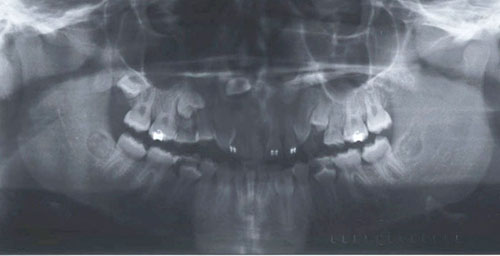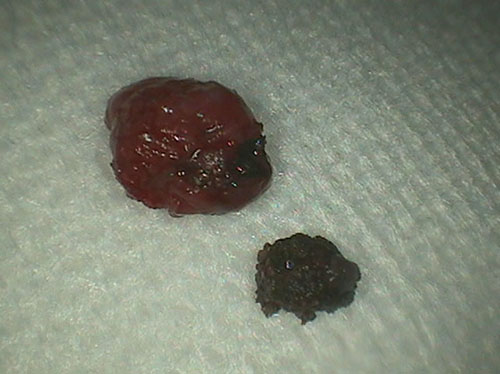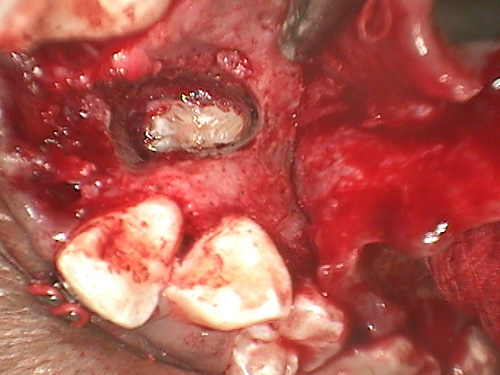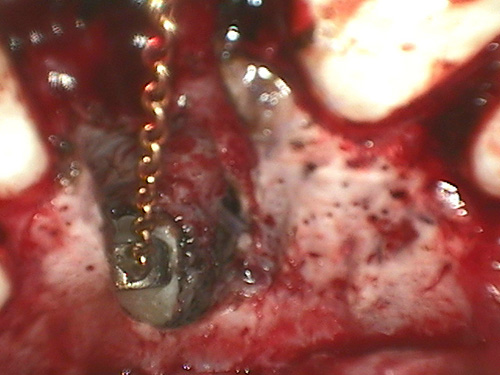Radiolucency anterior maxilla associated with impacted tooth #8
Can you make the correct diagnosis?

This is a 12-year old African American female who was referred by her general dentist for orthodontic evaluation and treatment because of failure of the deciduous incisors to exfoliate and tooth #8 to erupt.
Sorry! you are incorrect
The age of the patient and the radiographic findings are supportive of an odontoma. The histology was partially supportive of such diagnosis. Odontoma, whether complex or compound, hamartoma or neoplasm, accounts for 22% of all benign odontogenic tumors being the most common (1-4). It is of mixed epithelial and mesenchymal origin. It is usually associated with unerupted teeth (1-4). It can occur at any age, but is most common in the first two decades of life, with an average age of 14 to 18. It is slightly more common in females and more common in the maxilla, especially in the anterior maxilla (4). Compound odontomas are more common in the anterior jaws, while complex odontomas in the posterior jaws (2, 4). In about 80% of cases, they are associated with impacted or unerupted teeth. Radiographically, odontomas present as a well-circumscribed radiolucency resembling a dental follicle or dentigerous cyst with one or multiple radiopaque pieces resembling teeth (1). Compound odontomas tend to occur between teeth and tend to be composed of multiple small tooth-like structures, while complex odontomas tend to occur in the posterior jaws and present as a conglomerate mass. Both types are made up of enamel matrix, dentin, cementum, and dental pulp surrounded by a dental follicle or cyst. Histologically, the tooth-like structures are arranged in a uniform manner similar to the normal tooth. The structures in complex odontomas are mixed and disorganized. These lesions are benign and are conservatively treated with simple curettage (1-4). Recurrence is not described; if it recurs, one must rule out other odontogenic lesions such as calcifying odontogenic cyst or ameloblastic fibro-odontoma.
Sorry! you are incorrect
The radiographic changes, the age of the patient are consistent with an ameloblastic fibro-odontoma. The location is not supportive of this diagnosis while the histology is partially supportive of this diagnosis.
Ameloblastic fibroma was first described by Kruse in 1891. It is a relatively uncommon and is benign, slow-growing, expansile, neoplasm or hamartoma of mixed epithelial and mesenchymal odontogenic origin (4-6). Some suggest that this lesion may represent an early stage of an odontoma. Ameloblastic fibro-odontoma behaves like a neoplasm in terms of growth and expansion of the jaw bones. It is known to inhibit tooth eruption and is therefore often associated with impacted teeth. It can also displace teeth. Therefore, these lesions can go undetected by parents unless a noticeable expansion occurs or because of failure of tooth eruption and displacement of teeth. It is rarely painful. It occurs most commonly in children in the first and second decade of life ranging from infancy to 42 years of age (6). It has equal gender predilection and is more common in the posterior mandible than in the maxilla. It also occurs more often in the posterior jaw mandible than in the anterior jaws. Radiographic findings include an impacted/unerupted tooth with a well-defined, usually unilocular radiolucency around the crown of a tooth, similar to a dentigerous cyst. It may also present as a radiolucency containing radiopaque material ranging from flecks to small tooth-like structures. Because of the continued slow growth, this lesion can reach very large sizes if left untreated. The histology of ameloblastic fibro-odontoma is made up of mixed epithelial and mesenchymal tissues (5-6). The epithelial component presents in the form of small islands, cords and rosettes of epithelial cells with columnar and palisaded peripheries and with centers that may or may not contain stellate or cuboidal epithelial cells. The mesenchymal component is made up of primitive connective tissue stroma with tooth-like hard material that has features of a complex odontoma. They are benign and well-differentiated neoplasms; for that reason, transformation is rarely described. Conservative curettage and enucleation is the treatment of choice, and there is a very low recurrence rate (4-6). The involved tooth is usually extracted. It has a good prognosis.
Sorry! you are incorrect
The radiographic findings are consistent with a calcifying odontogenic cyst especially those that are associated with odontomas (7). The age of the patient is on the young range. The histology is partially supportive of this diagnosis.
Calcifying odontogenic cyst (COC) constitutes around 1% of all odontogenic cysts (7-9). Praetorius et al (8) were the first to classify COC into a spectrum ranging from a simple cystic structure to a solid neoplastic lesion. They classified the cystic type into subtypes A, B and C: A denoting a simple cyst, B an odontoma-producing cyst, and C a cyst with ameloblastomatous proliferating. COC tends to occur around the third decade, with a patient age range of 7-82 years (9-10). It occurs equally in the maxilla and mandible, usually anterior to the first permanent molar, though it has a predilection for occurrence in the maxilla in the younger age range. It occurs equally in males and females (9-10). COC occurs more commonly in bone, but it can also occur in soft tissue (in the gingiva without a bony component, also known as peripheral COC (8-10)). The peripheral counterpart of both lesions is less aggressive than the intra-osseous type (9). Histologically, COC ranges from simple cyst with ghost cells and focal ameloblastoma-like epithelial changes to more proliferative epithelium with ghost cells, to calcifications (both amorphous, tooth-like and calcified ghost cells) and to a true odontoma associated with such cyst. Pigmented COCs have been described and melanin constitutes the brown pigment. Radiographically, COCs tend to be well-defined radiolucencies with occasional small radiopacities. They can be present at the apex, between teeth, or associated with impacted teeth (8-10). Clinically, all COCs can expand the jaws and extend into the surrounding soft tissues and even the maxillary sinus. They can also resorb and displace teeth. Treatment of choice is thorough curettage.
Congratulations! You are correct
Combined COC with benign odontogenic neoplasms have been described but are very rare entities. A number of odontogenic neoplasms have been reported to occur in association with COC and those include ameloblastic fibroma, ameloblastic fibro-odontoma, ameloblastoma adenomatoid odontogenic tumor and odontomas (11). The latter would be the most common of all odontogenic tumors to occur in association with COC. At least three cases of COC associated with AFO have been reported (12-13). Some investigators prefer the name of hybrid tumors. The behavior of combined lesions is not known and therefore the clinical presentation and treatment is not well-understood. They seem to behave similar to what a COC and AFO would behave if occur alone and for that reason, the treatment should not be any different than that of COC alone or of AFO alone. This patient was treated with curettage and as of the time of writing this report, the lesion had not recurred.
Treatment
Under IV sedation, the area was accessed through the palate both to make a pathway for eruption, and to remove the contents of the radiolucent area. The lesion was soft in consistency. The central portion of the lesion was black and hard (Figure 2). The lesion was removed intact. The lingual aspect of the crown of tooth #8 was further exposed (Figure 6), a bracket and chain attached, and the chain brought through the incisor socket for orthodontic traction (Figure 7) to help the tooth to erupt.

Figure 2. This is a photograph of the dark hard and soft tissue removed from the area of impacted tooth #8.

Figure 6. This is a clinical photograph of the surgical site showing the impacted tooth #8.

Figure 7. This is a clinical photograph of the surgical site showing tooth #8 attached to a bracket and chain with the chain brought through the incisor socket for orthodontic traction.
References
- Vengal M, Arora H, Ghosh S. Large erupting complex odontoma: a case report. J Can Dent Assoc. 2007;73:169-73.
- Noonan VL, Gallagher G, Kabani S. Compound and complex odontomas. J Mass Dent Soc. 2006; 55: 40.
- Ogunlewe MO, Adeyemo WL, Ladeinde AL. Surgical management of a large complex odontoma of the mandibular angle-ramus region through intra-oral buccal approach–A case report. Niger Postgrad Med J. 2005;12: 312-5.
- Chen Y, Li TJ, Gao Y. Ameloblastic fibroma and related lesions: a clinicopathologic study with reference to their nature and interrelationship. J Oral Pathol Med. 2005; 34: 588-95.
- Dhanuthai K, Kongin K. Ameloblastic fibro-odontoma: a case report. J Clin Pediatr Dent. 2004; 29: 75-7.
- Oghli AA, Scuto I, Ziegler C. A large ameloblastic fibro-odontoma of the right mandible. Med Oral Patol Oral Cir Bucal. 2007; 12: E34-7.
- Gallana-Alvarez S, Mayorga-Jimenez F, Torres-Gomez FJ. Calcifying odontogenic cyst associated with complex odontoma: case report and review of the literature. Med Oral Patol Oral Cir Bucal. 2005; 10: 243-7.
- Praetorius F, Hjorting-Hansen E, Gorlin RJ, Vickers RA. Calcifying odontogenic cyst: range, variations and neoplastic potential. Acta Odonotol Scand 1981; 39: 227-240.
- Gorlin RJ, Pindborg JJ, Clausen FP, Vickers RA. The calcifying odontogenic cyst: a possible analogue of the cutaneous calcifying epithelioma of Malherbe. Oral Surg Oral Med Oral Pathol 1962;15:1235-43.
- Hong SP, Ellis GL, Hartman KS. Calcifying odontogenic cyst: a review of ninety-nine cases with reevaluation of their nature as cysts or neoplasms, the nature of ghost cells, and subclassification. Oral Surg Oral Med Oral Pathol 1991;72: 56-64.
- Lin C-C, Chen C-H, Lin L-M, Chen Y-K, Wright J, Kessler HP, Cheng LC, Ellis E. Calcifying odontogenic cyst with ameloblastic fibroma: report of three cases. Oral Surg. 2004; 98: 451-60.
- Farman AG, Smith SN, Nortje CJ, Grotepass FW. Calcifying odontogenic cyst and ameloblastic fibro-odontoma: one lesion or two?. J Oral Path1978; 7: 19-27.
- Matsuzaka K, Inoue T, Nashimoto M, Takemoto K, Ishikawa H, Asaka M. A case of an ameloblastic fibro-odontoma arising from calcifying odontogenic cyst. Bull Tokyo Dent Coll 2001; 42: 51-55.